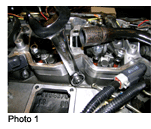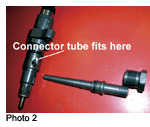With the massive number of diesel trucks that have hit the roads since around 1998, I believe there is an enormous amount of potential work for independent shops. One fact I thought was amazing is DaimlerChrysler claims that 70% of the Dodge Ram 2500 and 3500 truck market since 2003 is equipped with the 5.9L Cummins diesel engine.
I’ve found that most of these diesel owners are very maintenance-specific. In other words, most of this group change their oil and filters at the recommended intervals. In this article, I’ll share what I have learned on these newer electronic diesel engines — specifically the 2003-’07 Cummins 5.9L common rail injection system commonly found in the 2500/3500 Ram truck.
This engine came into production obviously for emissions reasons. It’s very quiet, emits no smoke and runs great. My main focus in this article will be the fuel system. That’s where most of the problems seemed to have surfaced.
Low and High Pressure Sides
Fuel starts at the tank and flows through the lift pump, which is mounted on the rear of the fuel filter housing. It is pressurized to approximately 11 psi and then moves through the filter element. From there it’s sent to the engine-mounted gear-driven pump, which pressurizes it to around 435 psi. Then the fuel travels into the electronic control actuator (ECA), which is pulse width modulated controlled by the ECM. After going through the ECA, it goes into the pumping chambers where pressure is raised to 4,351-23,206 psi depending on ECM command. Fuel then leaves the engine-mounted pump where it goes into the fuel rail, which in turn connects to the injectors.
The ECM uses various inputs to calculate fuel rail pressure — accelerator pedal position, ECT, IAT and rpm, just to name a few. There is a fuel rail pressure sensor on the fuel rail that tells the ECM actual pressure. The injectors are electrically wired into two banks. Bank one has cylinders 1, 2 and 3 and bank two has 4, 5 and 6. Firing order is typical inline six at 1, 5, 3, 6, 2 and 4. The injectors operate at 90 volts. There are two high-side drivers that connect to all three injectors on each bank. The low-side drivers are connected individually to each injector from the ECM.
Ninety volts is achieved when the ECM grounds the low-side driver of the injector that just fired for 160 milliseconds, which will saturate the coil, but not fire fuel into the engine. To elaborate, let’s say #1 just fired. The ECM will ground the #1 injector after it fires for 160 milliseconds to boost the voltage on that bank’s high-side capacitor in the ECM. The next cylinder to fire is #5, and so it fires. Voltage on bank one is at 90 volts and then #3 fires. While #3 fires, the ECM grounds #5 injector to boost the voltage on bank two. As you can see, this process repeats itself. In other words, an injector on bank one fires, then one on bank two fires. Once the injector fires it is grounded again to store voltage back into that bank’s capacitor, and is ready to fire the next cylinder in that bank’s sequence.
OK, now that we understand how the system works, let’s bring in the problem truck. It’s a 2003 Dodge Ram 3500 4×4 with a six-speed manual transmission. The customer just bought this truck and it was intermittently hard starting both hot and cold. Once started it ran great. Cranking times varied from 10 seconds all the way to 45 seconds. The truck has 116,000 miles on it. I asked the customer what recent maintenance he has had done, and he told me he replaced the fuel filter, but there was no change in the condition.
The first thing I did was plug in the DRB 3, but I found no codes. I checked the intake air heater operation and it was working fine. I ran over to my service information system and searched for TSBs. I grabbed a trouble tree for a hard/no start. The first step in the diagnostic tree was to connect the scan tool and check commanded rail pressure and actual rail pressure during cranking. The next step said to crank the engine for three to five seconds. It takes a minimum of 5,000 psi to start the engine. Commanded was at 5,305 psi. I cranked the engine for five seconds and the most pressure I saw from the fuel rail pressure sensor was almost 2,000 psi. If I cranked it for seven seconds it would finally build up to 5,000 psi and the engine would start and run fine.
The next thing the diagnostic tree called for was to check the low pressure side fuel pump pressure and flow. The spec is minimum 9.5 psi and it must flow 14.5 oz. in 10 seconds. You must use a scan tool to command the lift pump on for 10 seconds for this test.
The next test is to check for a restriction from the fuel tank to the lift pump. Using the same special tool for checking the fuel pressure, connect and vacuum gauge to the suction side of the pump. It must not pull more than 6 in. Hg. while the pump is commanded on by the scan tool. If more than 6 in. Hg. is pulled, a restriction exists and must be corrected first.
Then an excessive injector return flow test should be performed. I found a way to perform this test without using any major special tools. There are two rubber lines going from the fuel filter housing and the engine-mounted high pressure fuel pump. The upper one is a return line. Disconnect the upper return line. Route the end coming from the high pressure pump to dump into a bucket. Connect a hose on the other end that goes to the fuel filter housing into a graduated cylinder. Next block off the plastic return line going from the filter assembly to the fuel tank. Start the engine and let it idle. Record the amount of fuel in one minute. If it is more that 6 oz., you have too much fuel getting returned. I had almost 9 oz., which is way over the factory spec.
 Remove all six injector lines from the rail to the high pressure connectors (HPC), which feed the injectors the fuel, and re-torque each of them to 37 ft.-lbs. Now retest the return flow. (See Photo 1) When I did this, I noticed that the #1 HPC was very loose. All of the others were fine. I re-installed the fuel lines and started the engine. I re-tested the injector return flow to find I now had 5 oz., which is under the spec. I noticed right away it started fine, so I returned the truck to the customer.
Remove all six injector lines from the rail to the high pressure connectors (HPC), which feed the injectors the fuel, and re-torque each of them to 37 ft.-lbs. Now retest the return flow. (See Photo 1) When I did this, I noticed that the #1 HPC was very loose. All of the others were fine. I re-installed the fuel lines and started the engine. I re-tested the injector return flow to find I now had 5 oz., which is under the spec. I noticed right away it started fine, so I returned the truck to the customer.
Two weeks passed and the customer calls to tell me that the problem has resurfaced. He said that cranking times are increasing every day. He stated that it started fine for the first 400 miles then it progressively got worse. He brought the truck back and I went through the diagnostic procedure again. I ended up back at the injector return flow test. It was now worse than before – at almost 11 oz. return fuel in one minute. I removed all six injector lines again and checked the torque on the HPCs. They were all on the money at 37 ft.-lbs.
The next step in the procedure was to block off each injector at the rail and start the engine and perform the return fuel test. Repeat this test for each injector until you get less than 5 oz. return fuel. Once you do, you’ll know which injector and/or HPC is the problem. If you remember, I noticed that #1 injector HPC nut was very loose the first time the customer brought the truck in two weeks prior. I blocked off #1 injector and bingo… I had 3 oz. return fuel. I removed the HPC nut and inspected the HPC for damage, but couldn’t find any. I knew I needed to replace that injector and the HPC.
 I called my local Dodge dealer and ordered an injector and an HPC. I installed them and performed the return test. I had 4 oz. return fuel and the engine started great. I was relieved and very pleased. It didn’t look like a fun job to remove all six injector lines and to perform the block off test six times. I was very glad that I found the problem on #1 cylinder.
I called my local Dodge dealer and ordered an injector and an HPC. I installed them and performed the return test. I had 4 oz. return fuel and the engine started great. I was relieved and very pleased. It didn’t look like a fun job to remove all six injector lines and to perform the block off test six times. I was very glad that I found the problem on #1 cylinder.
I wondered if a loose HPC could cause excessive return flow and not get into the engine oil? A closer inspection with the injector indicated that where the HPC bottoms in the injector that the return orifice can be reached by a cracked or loose HPC. (See Photo 2.) There is an injector return passage inside the cylinder head that takes the unused fuel from each injector and returns it to the fuel filter. There are two return lines going to the filter. One from the injectors and the other from the engine-driven gear pump.
Some notes about this engine: TSB# 14-003-06 was a big help. I could not find this TSB in my service information. For this job I subscribed to DaimlerChrysler’s service website, www.techauthority.com. For $20 a day you have factory access to TSBs, service information and even training material. My opinion is that these service websites are underutilized. Go to www.nastf.org for all manufacturers’ websites. I ordered the special tools through Miller. Visit www.spx.miller.com for more information and ordering.
Chris Hamann is an ASE-certified Master Tech and Master Machinist at Lakeland Auto & Marine in Port Clinton, OH, a family-owned engine rebuilding shop and automotive and marine full-service repair center established in 1990.
